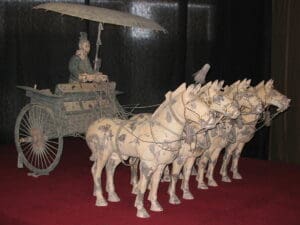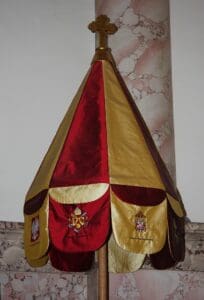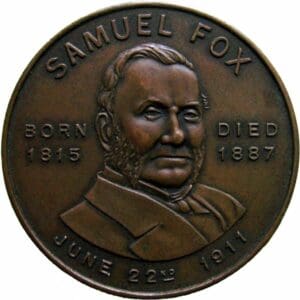30 Amazing Facts about the Inventor of the Umbrella and Its Evolution
Have you ever stopped to wonder who first came up with the brilliant idea of an umbrella? The invention that has kept us dry during unexpected showers and shielded us from the scorching sun? I must admit, I have always been curious as well.
Like many inventions before our time, the exact origins of the umbrella are uncertain. Umbrellas have been used in different forms by various cultures throughout history. The ancient Egyptians, Greeks, and Romans all had various types of sunshades.
However, the modern collapsible umbrella, as we know it today, was likely invented in the 16th century in either China or Persia. These early umbrellas were primarily used for shade from the sun rather than protection from rain.
In this article, we will focus on the contributions of a man named Samuel Fox in the mid-19th century. Fox, an English engineer and industrialist, patented an innovative mechanism that made umbrellas much more durable and effectively waterproof. Join me as I uncover 30 amazing facts about the evolution of the Umbrella and the role Samuel Fox played in its invention.
1. The earliest evidence of umbrellas dates back to ancient civilizations

Image: Wikimedia Commons
The earliest evidence of umbrellas in ancient civilizations suggests that they were primarily used as sunshades. In Egypt, umbrellas made from palm leaves or feathers were used to protect individuals from the harsh sun. In Greece and Rome, similar sunshades were used, often made from materials like cloth or animal skin.
2. The word “umbrella” is Latin
The word “umbrella” comes from the Latin word “umbra,” which means shade or shadow. This term accurately represents the purpose of an umbrella, as it provides shade and protection from the sun or rain.
3. In ancient China, umbrellas were made from silk or paper

Jonathunder, GFDL 1.2, via Wikimedia Commons
Ancient China had its version of the umbrella, which had a canopy made from silk or paper and a frame usually made from bamboo. These elegant umbrellas, known as “gai shi,” were used as a form of protection from the sun or rain and were a symbol of status and wealth. The art of umbrella making in China was highly developed, with skilled craftsmen creating intricate designs and patterns on the canopy.
4. European travelers and merchants encountered umbrellas in the Middle East
European travelers and merchants encountered umbrellas during their visits to the Middle East in the 16th century. The use of umbrellas in this region was influenced by the Chinese and Persian cultures. The European travelers were impressed by the practicality and usefulness of these umbrellas and decided to bring them back to Europe. Umbrellas quickly gained popularity among the European aristocracy and upper classes as a fashionable accessory.
5. The first collapsible umbrella was invented in the 16th century

Richtom80 at the English-language Wikipedia, CC BY-SA 3.0, via Wikimedia Commons
The first collapsible umbrella, as we know it today, was invented in the 16th century, either in China or Persia. These umbrellas were designed with a folding mechanism, allowing them to be easily compacted and carried. This innovation made them more practical for daily use and travel. However, it is still unclear whether the collapsible umbrella was first developed in China or Persia, as both cultures had a long history of umbrella usage and innovation.
6. Umbrellas became popular in the 18th century
By the 18th century, umbrellas had become a staple accessory among the English gentry. They were often made from luxurious materials like silk and adorned with intricate designs and embroidery. These umbrellas were not only functional but also served as a symbol of status and wealth.
7. Samuel Fox’s invention greatly improved the umbrella’s functionality
In the 19th century, Samuel Fox, an English inventor, revolutionized umbrella design with his invention of the lightweight steel ribbed umbrella frame. This innovation greatly improved the umbrella’s functionality, making it more durable, resistant to rain and wind, and easier to open and close. Fox’s design became the standard for modern umbrella frames.
8. The use of wax and lacquer-inspired waterproof umbrellas in Europe
The use of wax and lacquer to waterproof paper parasols in ancient China greatly influenced early attempts to create waterproof umbrellas in Europe. Umbrella makers began experimenting with various waterproofing techniques such as applying oil or melted wax to the fabric. These early attempts laid the foundation for future advancements in umbrella waterproofing.
9. The canopy materials of umbrellas evolved in the 19th century

No machine-readable author provided. Gyrofrog assumed (based on copyright claims)., CC BY-SA 2.5, via Wikimedia Commons
In the late 19th century, the canopy materials of umbrellas evolved to include oil-treated cotton. This advancement provided better waterproofing compared to previous materials. The oil-treated cotton not only repel water but also made the fabric more durable and resistant to tearing.
10. Synthetic materials led to more durable and waterproof umbrellas
The 20th century saw significant advancements in umbrella technology, particularly in the development of synthetic materials. Fabrics such as nylon and polyester were introduced, offering superior durability, waterproofing, and resistance to UV rays. These synthetic materials revolutionized the umbrella industry, making umbrellas more reliable and long-lasting. Additionally, advancements in manufacturing techniques allowed for the mass production of umbrellas, making them more accessible to a wider range of people. Today, umbrellas come in various sizes, styles, and colors, with options for automatic opening and closing mechanisms, windproof features, and even umbrellas with built-in UV protection.
11. Mitsuo Sudou revolutionized the umbrella industry in 1984
Mitsuo Sudou, a Japanese inventor, made a significant impact on the umbrella industry in 1984 with his invention of the pocket umbrella, also known as the compact umbrella or collapsible umbrella. This groundbreaking design allowed umbrellas to be folded into a compact size, making them easily portable and convenient for everyday use. Sudou’s pocket umbrella featured a telescopic shaft that could be extended and retracted, allowing the umbrella to collapse and fit into a small storage pouch or even a pocket. This innovation quickly gained popularity and became a staple accessory for individuals looking for a compact and practical solution to protect themselves from rain or sunlight.
12. The umbrella’s automatic open and close mechanism
The mid-20th century brought another major innovation in umbrella technology with the introduction of the automatic open and close mechanism. This mechanism, operated with the push of a button, eliminated the traditional manual opening and closing of umbrellas. Electrically powered or spring-loaded mechanisms were incorporated into the umbrella’s handle, allowing users to effortlessly open or close their umbrellas with ease. This advancement greatly improved the convenience and user experience of using umbrellas, particularly in situations where quick and efficient protection from rain or sun was needed.
13. In recent years, there have been advancements in umbrella technology
In recent years, there have been significant advancements in umbrella technology, particularly in the development of windproof designs. These windproof umbrellas are specifically engineered to withstand strong winds and gusts without flipping inside out or breaking. One of the key features of windproof umbrellas is their reinforced frame, often made from materials like fiberglass or carbon fiber, which provides extra strength and flexibility.
Additionally, windproof umbrellas may have a double-canopy construction, with a vented top layer that allows wind to pass through, reducing the risk of inversion. Some windproof umbrellas also incorporate an aerodynamic shape and added stability features, such as reinforced ribs and a sturdy handle grip, to further enhance their wind resistance capabilities. These innovations have made umbrellas more reliable and durable in adverse weather conditions, providing users with a higher level of protection and reliability.
14. The fashion industry has embraced umbrellas as a stylish accessory
Umbrellas have transcended their practical function and have become a fashion statement in recent years. The fashion industry has embraced umbrellas as a stylish accessory, offering a wide array of designs, patterns, and colors to suit individual tastes and preferences. From classic solid-colored umbrellas to vibrant and playful prints, there is a diverse range of options available in the market. Some high-end fashion brands have even collaborated with umbrella manufacturers to create designer umbrellas, featuring their signature logos, patterns, and aesthetics. With their ability to add flair and a touch of personal style to rainy or sunny days, umbrellas have become a fashionable and eye-catching accessory that complements and enhances an individual’s overall look.
15. Umbrellas have various practical applications beyond rain protection

Silverije, CC BY-SA 4.0, via Wikimedia Commons
Umbrellas have also found practical applications beyond their primary purpose of rain protection. In the world of photography, umbrellas are commonly used as lighting modifiers. They can be used to diffuse and soften light, creating a more flattering and evenly distributed illumination for subjects. Umbrellas used in photography typically have a reflective inner lining that helps to bounce and scatter light, resulting in a softer and more diffused lighting effect.
Furthermore, umbrellas have become an integral part of outdoor events and occasions. In weddings, for example, umbrellas are often incorporated into the ceremony or reception decorations. They can be used to provide shade for outdoor seating areas or to create a stunning visual display when hung upside down from ceilings or attached to outdoor structures. Umbrellas also find use in festivals and outdoor gatherings, where they provide shelter from the elements and add a vibrant and festive atmosphere.
Lastly, umbrellas have found a role in advertising and promotional activities. As an everyday item used by a wide range of people, umbrellas present an excellent opportunity for companies and brands to showcase their logo, slogan, or message.
Facts about Samuel Fox
16. Samuel Fox was born in Bradfield, England
Samuel Fox was born on May 11, 1815, in Bradfield, England. He was the son of William Fox and Mary Fox (née Bacon). Fox grew up in a family that was involved in the steel manufacturing industry. His father was a prominent steel manufacturer in the region.
17. He came from a family of steel manufacturers and engineers
Fox belonged to a family with a strong legacy in steel manufacturing and engineering. His father, William Fox, was a successful steel manufacturer who ran a steelworks in Bradfield, England. The family had been involved in the steel industry for several generations. Fox’s grandfather, Samuel Fox Sr., was also renowned as an engineer and inventor. He was known for his innovations in the production of steel wire and the development of new steel-related technologies.
18. Fox founded the Fox Umbrella Frame Company
In 1842, Samuel Fox founded the Fox Umbrella Frame Company in Sheffield, England. The company specializes in manufacturing umbrella frames using steel. Sheffield was an ideal location for such a venture, as it was known for its steel industry and the production of cutlery and tools. Fox’s company quickly gained a reputation for producing high-quality umbrella frames.
19. Samuel Fox patented a design in 1852 for an improved umbrella frame
In 1852, Samuel Fox patented a design for an improved umbrella frame. His design incorporated lightweight steel ribs and a more efficient opening and closing mechanism. The lightweight steel ribs made the umbrella sturdier and more resistant to strong winds, while the improved opening and closing mechanism enhanced its functionality. This patent showcased Fox’s innovative approach to umbrella design and set a new standard for umbrella manufacturing.
20. Fox’s design made umbrellas more durable and resistant to wind and rain
Samuel Fox’s improved umbrella frame design made umbrellas more durable and resistant to wind and rain. The use of lightweight steel ribs addressed the common issue of umbrellas being easily damaged or overturned in windy conditions. This innovation made umbrellas more practical and reliable for everyday use. The strength and durability of the steel frame also increased the overall lifespan of the umbrella, reducing the need for frequent replacements. Fox’s design greatly contributed to the modernization and improvement of umbrella technology, making umbrellas more efficient and reliable for protection against the elements.
21. Samuel Fox a tensioning system to keep the umbrella taut
In addition to the lightweight steel ribs, Samuel Fox introduced the use of a flexible metal joint and a tensioning system in his umbrella design. These features helped to keep the umbrella taut and prevent sagging or folding in heavy rain or wind. The flexible metal joint allowed for easy movement and adjustability, enhancing the usability of the umbrella.
22. Fox’s invention allowed the umbrella to withstand strong winds
The lightweight steel ribs used in Fox’s umbrellas were not only strong but also flexible. This allowed the umbrella to withstand strong winds without breaking or inverting. The flexibility of the steel ribs made the umbrella more resilient, making it a reliable choice even in adverse weather conditions.
23. Fox’s umbrella design quickly gained popularity
Samuel Fox’s innovative umbrella design quickly gained popularity and became the basis for the modern collapsible umbrella. The lightweight yet strong steel frame, along with its efficient opening and closing mechanism, made Fox’s umbrellas highly sought after. The collapsible feature made it convenient for people to carry and store the umbrella when not in use. Fox’s design revolutionized the umbrella industry and set the standard for the modern umbrellas we use today.
24. Fox patented other inventions
Apart from his contributions to umbrella design, Samuel Fox also patented several other inventions. He held patents for innovations in fencing wire, steel springs, and railway construction. These additional patents demonstrate Fox’s versatile skills and wide-ranging interests in various areas of engineering and manufacturing. His inventive mindset and ability to come up with practical solutions to different challenges contributed to his success as an inventor and entrepreneur.
25. Fox’s umbrella frames were exported to many countries
Samuel Fox’s umbrella frames were not only popular in England but were also exported to many countries around the world. His company, the Fox Umbrella Frame Company, became a major global supplier of umbrella frames. The reputation of Fox’s umbrellas for their durability and quality made them highly sought after internationally. The exportation of his umbrella frames further solidified Fox’s status as a leading figure in the umbrella manufacturing industry. His company’s success in supplying umbrella frames to different countries demonstrated the global impact of his inventions and the recognition he received worldwide.
26. Samuel Fox was known for his passion for innovation
Samuel Fox was known for his passion for innovation and his relentless pursuit of improvement. He constantly sought ways to enhance the functionality and durability of his umbrella frames. This drive for innovation allowed him to stay at the forefront of the umbrella industry and maintain the reputation of his company as a provider of high-quality products.
27. Fox’s umbrella frames were made with high-quality materials
The umbrella frames produced by the Fox Umbrella Frame Company were not only known for their durability but also their aesthetic appeal. Fox emphasized the importance of design and used high-quality materials to create umbrella frames that were not only functional but also visually pleasing. The frames were often decorated with intricate designs, adding a touch of elegance to the umbrella.
28. Fox’s company received prestigious awards
Fox’s commitment to excellence and innovation earned his company international recognition. The Fox Umbrella Frame Company received prestigious awards, including a gold medal at the Great Exhibition in London in 1851. This recognition further established Fox as a pioneer in umbrella technology and solidified his company’s reputation as a leader in the industry.
29. Samuel Fox was involved in public service
In addition to his achievements in the business world, Samuel Fox was also involved in public service. He held positions such as Sheriff and Master Cutler in Sheffield. These positions allowed him to contribute to the local community and maintain close ties with the city’s manufacturing and steel industry.
30. Samuel Fox died in 1887
Samuel Fox passed away on November 24, 1887, leaving behind a lasting legacy as an innovator in umbrella technology. His contributions to the industry revolutionized the design and functionality of umbrellas, making them more durable, resistant to wind and rain, and convenient for everyday use. The Fox Umbrella Frame Company continued to thrive after his death, carrying on his innovative spirit and maintaining its reputation as a leading manufacturer of umbrella frames. Today, the modern umbrella owes much of its design and functionality to Samuel Fox’s pioneering work and his commitment to pushing the boundaries of innovation.
Samuel Fox played a pivotal role in shaping the history of umbrellas and revolutionizing the way we protect ourselves from the rain. From his groundbreaking invention of the steel-ribbed umbrella to his numerous other inventions and innovations, Fox’s impact is undeniable. Through his determination and entrepreneurial spirit, he not only changed the umbrella industry but also contributed to advancements in various other fields. His legacy lives on today, as umbrellas continue to be an essential accessory in our daily lives. We owe a debt of gratitude to Samuel Fox for his remarkable contributions to the evolution of the umbrella and for making rainy days a little bit brighter.
Planning a trip to Paris ? Get ready !
These are Amazon’s best-selling travel products that you may need for coming to Paris.
Bookstore
- The best travel book : Rick Steves – Paris 2023 – Learn more here
- Fodor’s Paris 2024 – Learn more here
Travel Gear
- Venture Pal Lightweight Backpack – Learn more here
- Samsonite Winfield 2 28″ Luggage – Learn more here
- Swig Savvy’s Stainless Steel Insulated Water Bottle – Learn more here
Check Amazon’s best-seller list for the most popular travel accessories. We sometimes read this list just to find out what new travel products people are buying.












